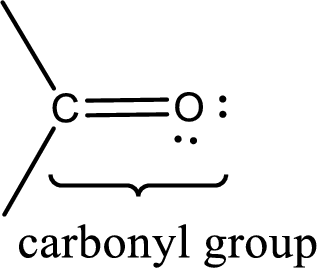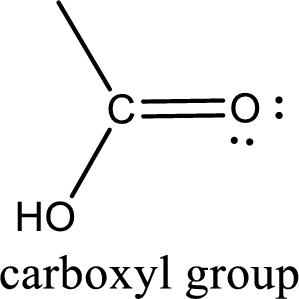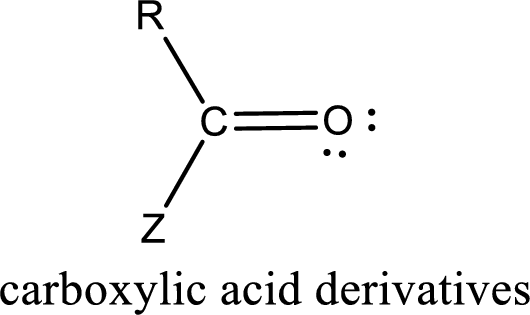
EBK GENERAL, ORGANIC, AND BIOLOGICAL CH
7th Edition
ISBN: 9780100853188
Author: STOKER
Publisher: YUZU
expand_more
expand_more
format_list_bulleted
Concept explainers
Question
Chapter 16.17, Problem 1QQ
Interpretation Introduction
Interpretation:
Correct general formula of thioester has to be chosen from the given options.
Concept Introduction:
Carbonyl groups are the one which contain a double bond between carbon and oxygen atom.

If a hydroxyl group is attached to a carbonyl group means it is known as carboxyl group. This can be represented as shown below,


Expert Solution & Answer
Want to see the full answer?
Check out a sample textbook solution
Students have asked these similar questions
Lab Data
The distance entered is out of the expected range.
Check your calculations and conversion factors.
Verify your distance. Will the gas cloud be closer to the cotton ball with HCI or NH3?
Did you report your data to the correct number of significant figures?
- X
Experimental Set-up
HCI-NH3
NH3-HCI
Longer Tube
Time elapsed (min)
5 (exact)
5 (exact)
Distance between cotton balls (cm)
24.30
24.40
Distance to cloud (cm)
9.70
14.16
Distance traveled by HCI (cm)
9.70
9.80
Distance traveled by NH3 (cm)
14.60
14.50
Diffusion rate of HCI (cm/hr)
116
118
Diffusion rate of NH3 (cm/hr)
175.2
175.2
How to measure distance and calculate rate
For the titration of a divalent metal ion (M2+) with EDTA, the stoichiometry of the reaction is typically:
1:1 (one mole of EDTA per mole of metal ion)
2:1 (two moles of EDTA per mole of metal ion)
1:2 (one mole of EDTA per two moles of metal ion)
None of the above
Please help me solve this reaction.
Chapter 16 Solutions
EBK GENERAL, ORGANIC, AND BIOLOGICAL CH
Ch. 16.1 - Prob. 1QQCh. 16.1 - Prob. 2QQCh. 16.1 - Prob. 3QQCh. 16.1 - Prob. 4QQCh. 16.1 - Prob. 5QQCh. 16.2 - Prob. 1QQCh. 16.2 - Prob. 2QQCh. 16.2 - Prob. 3QQCh. 16.2 - Prob. 4QQCh. 16.2 - Prob. 5QQ
Ch. 16.3 - Prob. 1QQCh. 16.3 - Prob. 2QQCh. 16.3 - Prob. 3QQCh. 16.4 - Prob. 1QQCh. 16.4 - Prob. 2QQCh. 16.4 - Prob. 3QQCh. 16.5 - Prob. 1QQCh. 16.5 - Prob. 2QQCh. 16.5 - Prob. 3QQCh. 16.6 - Prob. 1QQCh. 16.6 - Prob. 2QQCh. 16.7 - Prob. 1QQCh. 16.7 - Prob. 2QQCh. 16.7 - Prob. 3QQCh. 16.8 - Prob. 1QQCh. 16.8 - Prob. 2QQCh. 16.8 - Prob. 3QQCh. 16.8 - Prob. 4QQCh. 16.9 - Prob. 1QQCh. 16.9 - Prob. 2QQCh. 16.10 - Prob. 1QQCh. 16.10 - Prob. 2QQCh. 16.11 - Prob. 1QQCh. 16.11 - Prob. 2QQCh. 16.11 - Prob. 3QQCh. 16.12 - Prob. 1QQCh. 16.12 - Prob. 2QQCh. 16.12 - Prob. 3QQCh. 16.12 - Prob. 4QQCh. 16.13 - Prob. 1QQCh. 16.13 - Prob. 2QQCh. 16.14 - Prob. 1QQCh. 16.14 - Prob. 2QQCh. 16.14 - Prob. 3QQCh. 16.15 - Prob. 1QQCh. 16.15 - Prob. 2QQCh. 16.15 - Prob. 3QQCh. 16.16 - Prob. 1QQCh. 16.16 - Prob. 2QQCh. 16.16 - Prob. 3QQCh. 16.17 - Prob. 1QQCh. 16.17 - Prob. 2QQCh. 16.18 - Prob. 1QQCh. 16.18 - Prob. 2QQCh. 16.18 - Prob. 3QQCh. 16.19 - Prob. 1QQCh. 16.19 - Prob. 2QQCh. 16.19 - Prob. 3QQCh. 16.19 - Prob. 4QQCh. 16.20 - Prob. 1QQCh. 16.20 - Prob. 2QQCh. 16.20 - Prob. 3QQCh. 16.20 - Prob. 4QQCh. 16 - Prob. 16.1EPCh. 16 - Prob. 16.2EPCh. 16 - Prob. 16.3EPCh. 16 - Prob. 16.4EPCh. 16 - Prob. 16.5EPCh. 16 - Prob. 16.6EPCh. 16 - Prob. 16.7EPCh. 16 - Prob. 16.8EPCh. 16 - Prob. 16.9EPCh. 16 - Prob. 16.10EPCh. 16 - Prob. 16.11EPCh. 16 - Prob. 16.12EPCh. 16 - Prob. 16.13EPCh. 16 - Prob. 16.14EPCh. 16 - Prob. 16.15EPCh. 16 - Prob. 16.16EPCh. 16 - Prob. 16.17EPCh. 16 - Prob. 16.18EPCh. 16 - Prob. 16.19EPCh. 16 - Prob. 16.20EPCh. 16 - Prob. 16.21EPCh. 16 - Prob. 16.22EPCh. 16 - Prob. 16.23EPCh. 16 - Prob. 16.24EPCh. 16 - Prob. 16.25EPCh. 16 - Prob. 16.26EPCh. 16 - Prob. 16.27EPCh. 16 - Prob. 16.28EPCh. 16 - Prob. 16.29EPCh. 16 - Prob. 16.30EPCh. 16 - Prob. 16.31EPCh. 16 - Prob. 16.32EPCh. 16 - Prob. 16.33EPCh. 16 - Prob. 16.34EPCh. 16 - Prob. 16.35EPCh. 16 - Prob. 16.36EPCh. 16 - Prob. 16.37EPCh. 16 - Prob. 16.38EPCh. 16 - Prob. 16.39EPCh. 16 - Prob. 16.40EPCh. 16 - Determine the maximum number of hydrogen bonds...Ch. 16 - Prob. 16.42EPCh. 16 - Prob. 16.43EPCh. 16 - Prob. 16.44EPCh. 16 - Prob. 16.45EPCh. 16 - Prob. 16.46EPCh. 16 - Prob. 16.47EPCh. 16 - Prob. 16.48EPCh. 16 - Prob. 16.49EPCh. 16 - Prob. 16.50EPCh. 16 - Prob. 16.51EPCh. 16 - Prob. 16.52EPCh. 16 - Prob. 16.53EPCh. 16 - Prob. 16.54EPCh. 16 - Prob. 16.55EPCh. 16 - Prob. 16.56EPCh. 16 - Give the IUPAC name for each of the following...Ch. 16 - Give the IUPAC name for each of the following...Ch. 16 - Prob. 16.59EPCh. 16 - Give the common name for each of the carboxylic...Ch. 16 - Prob. 16.61EPCh. 16 - Write a chemical equation for the preparation of...Ch. 16 - Prob. 16.63EPCh. 16 - Prob. 16.64EPCh. 16 - Prob. 16.65EPCh. 16 - Prob. 16.66EPCh. 16 - Prob. 16.67EPCh. 16 - Prob. 16.68EPCh. 16 - Prob. 16.69EPCh. 16 - Prob. 16.70EPCh. 16 - Prob. 16.71EPCh. 16 - Prob. 16.72EPCh. 16 - Prob. 16.73EPCh. 16 - Prob. 16.74EPCh. 16 - Prob. 16.75EPCh. 16 - Prob. 16.76EPCh. 16 - Prob. 16.77EPCh. 16 - Prob. 16.78EPCh. 16 - Prob. 16.79EPCh. 16 - Prob. 16.80EPCh. 16 - Prob. 16.81EPCh. 16 - Prob. 16.82EPCh. 16 - Prob. 16.83EPCh. 16 - Prob. 16.84EPCh. 16 - Prob. 16.85EPCh. 16 - Prob. 16.86EPCh. 16 - Prob. 16.87EPCh. 16 - Prob. 16.88EPCh. 16 - Prob. 16.89EPCh. 16 - Prob. 16.90EPCh. 16 - Prob. 16.91EPCh. 16 - Prob. 16.92EPCh. 16 - Assign an IUPAC name to each of the following...Ch. 16 - Prob. 16.94EPCh. 16 - Prob. 16.95EPCh. 16 - Prob. 16.96EPCh. 16 - Prob. 16.97EPCh. 16 - Prob. 16.98EPCh. 16 - Prob. 16.99EPCh. 16 - Prob. 16.100EPCh. 16 - How many carbon atoms are present in a molecule of...Ch. 16 - Prob. 16.102EPCh. 16 - Prob. 16.103EPCh. 16 - Prob. 16.104EPCh. 16 - Prob. 16.105EPCh. 16 - Prob. 16.106EPCh. 16 - Prob. 16.107EPCh. 16 - Prob. 16.108EPCh. 16 - Prob. 16.109EPCh. 16 - Prob. 16.110EPCh. 16 - Prob. 16.111EPCh. 16 - Prob. 16.112EPCh. 16 - Prob. 16.113EPCh. 16 - Prob. 16.114EPCh. 16 - Prob. 16.115EPCh. 16 - Prob. 16.116EPCh. 16 - Prob. 16.117EPCh. 16 - Prob. 16.118EPCh. 16 - Prob. 16.119EPCh. 16 - Prob. 16.120EPCh. 16 - Prob. 16.121EPCh. 16 - Prob. 16.122EPCh. 16 - Prob. 16.123EPCh. 16 - Prob. 16.124EPCh. 16 - Prob. 16.125EPCh. 16 - Prob. 16.126EPCh. 16 - Prob. 16.127EPCh. 16 - Prob. 16.128EPCh. 16 - Prob. 16.129EPCh. 16 - Prob. 16.130EPCh. 16 - Prob. 16.131EPCh. 16 - Prob. 16.132EPCh. 16 - Prob. 16.133EPCh. 16 - Prob. 16.134EPCh. 16 - Prob. 16.135EPCh. 16 - Prob. 16.136EPCh. 16 - Prob. 16.137EPCh. 16 - Prob. 16.138EPCh. 16 - Prob. 16.139EPCh. 16 - Prob. 16.140EPCh. 16 - Prob. 16.141EPCh. 16 - Prob. 16.142EPCh. 16 - Prob. 16.143EPCh. 16 - Prob. 16.144EPCh. 16 - Prob. 16.145EPCh. 16 - Prob. 16.146EPCh. 16 - Prob. 16.147EPCh. 16 - Prob. 16.148EPCh. 16 - Draw a condensed structural formula for the...Ch. 16 - Prob. 16.150EPCh. 16 - Prob. 16.151EPCh. 16 - Prob. 16.152EPCh. 16 - Prob. 16.153EPCh. 16 - Prob. 16.154EPCh. 16 - Prob. 16.155EPCh. 16 - Prob. 16.156EPCh. 16 - Prob. 16.157EPCh. 16 - Prob. 16.158EPCh. 16 - Prob. 16.159EPCh. 16 - Prob. 16.160EPCh. 16 - Prob. 16.161EPCh. 16 - Prob. 16.162EPCh. 16 - Prob. 16.163EPCh. 16 - Prob. 16.164EP
Knowledge Booster
Learn more about
Need a deep-dive on the concept behind this application? Look no further. Learn more about this topic, biology and related others by exploring similar questions and additional content below.Similar questions
- Indicate the products obtained by mixing 2,2-dimethylpropanal with acetaldehyde and sodium ethoxide in ethanol.arrow_forwardSynthesize 2-Ethyl-3-methyloxirane from dimethyl(propyl)sulfonium iodide using the necessary organic or inorganic reagents. Draw the structures of the compounds.arrow_forwardSynthesize 2-Hydroxy-2-phenylacetonitrile from phenylmethanol using the necessary organic or inorganic reagents. Draw the structures of the compounds.arrow_forward
- Synthesize N-Methylcyclohexylamine from cyclohexanol using the necessary organic or inorganic reagents. Draw the structures of the compounds.arrow_forwardSynthesize N-Methylcyclohexylamine from cyclohexanol using the necessary organic or inorganic reagents. Draw the structures of the compounds.arrow_forwardIf possible, please provide the formula of the compound 3,3-dimethylbut-2-enal.arrow_forward
- Synthesize 1,4-dibromobenzene from acetanilide (N-phenylacetamide) using the necessary organic or inorganic reagents. Draw the structures of the compounds.arrow_forwardIndicate the products obtained by mixing (3-oxo-3-phenylpropyl)triphenylphosphonium bromide with sodium hydride.arrow_forwardWe mix N-ethyl-2-hexanamine with excess methyl iodide and followed by heating with aqueous Ag2O. Indicate the major products obtained.arrow_forward
- Indicate the products obtained by mixing acetophenone with iodine and NaOH.arrow_forwardIndicate the products obtained by mixing 2-Propanone and ethyllithium and performing a subsequent acid hydrolysis.arrow_forwardIndicate the products obtained if (E)-2-butenal and 3-oxo-butanenitrile are mixed with sodium ethoxide in ethanol.arrow_forward
arrow_back_ios
SEE MORE QUESTIONS
arrow_forward_ios
Recommended textbooks for you
 Organic And Biological ChemistryChemistryISBN:9781305081079Author:STOKER, H. Stephen (howard Stephen)Publisher:Cengage Learning,
Organic And Biological ChemistryChemistryISBN:9781305081079Author:STOKER, H. Stephen (howard Stephen)Publisher:Cengage Learning, General, Organic, and Biological ChemistryChemistryISBN:9781285853918Author:H. Stephen StokerPublisher:Cengage Learning
General, Organic, and Biological ChemistryChemistryISBN:9781285853918Author:H. Stephen StokerPublisher:Cengage Learning

Organic And Biological Chemistry
Chemistry
ISBN:9781305081079
Author:STOKER, H. Stephen (howard Stephen)
Publisher:Cengage Learning,

General, Organic, and Biological Chemistry
Chemistry
ISBN:9781285853918
Author:H. Stephen Stoker
Publisher:Cengage Learning